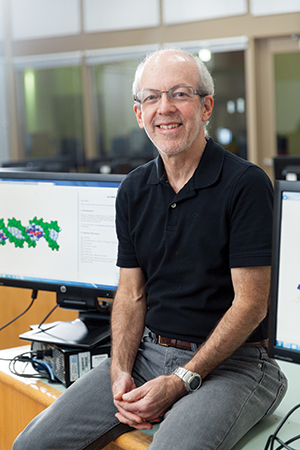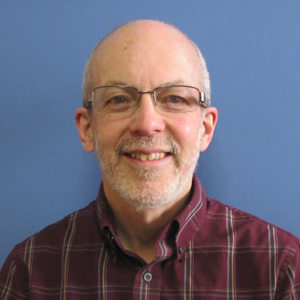Carbon dioxide 400
As I listened to my children speak of both global and local economic and social upheavals arising from climate-related migrations and environmental changes, I started to envision a dismal future for them. I heard young people questioning whether they should have children in an increasingly unstable and insecure world. I felt a growing sense of guilt. As a member of the generation that bequeathed them this future, and as a scientist/educator, have I failed in communicating the power of science to address societal concerns? Am I partly to blame for the growing disbelief in the process of science, especially as related to climate change?
 Henry Jakubowski, a professor of chemistry at the College of St. Benedict/St. John’s University, talks about the effects of climate change in all his classes and organized “Our Climate Futures,” a panel discussion with faculty from diverse disciplines. Courtesy of College of st. benedict/st. john's university When the concentration of atmospheric carbon dioxide passed 400 parts per million in June 2016, I felt a sense of urgency. The last time CO2 was 400 ppm was 3.5 million years ago in the Pliocene Epoch, when the poles were 10 F warmer and sea levels were 16 to 131 feet higher.
Henry Jakubowski, a professor of chemistry at the College of St. Benedict/St. John’s University, talks about the effects of climate change in all his classes and organized “Our Climate Futures,” a panel discussion with faculty from diverse disciplines. Courtesy of College of st. benedict/st. john's university When the concentration of atmospheric carbon dioxide passed 400 parts per million in June 2016, I felt a sense of urgency. The last time CO2 was 400 ppm was 3.5 million years ago in the Pliocene Epoch, when the poles were 10 F warmer and sea levels were 16 to 131 feet higher.
When the U.S. pulled out of the Paris climate accord and began removing environmental regulations, my sense of urgency increased. After decades of teaching, I asked myself, What can I do? More importantly, what should I do?
I have taught aspects of climate change, but mostly to nonscience majors in courses designed to address social issues. In those classes, I could focus on the process of science. For example, by reading sections of Thomas Kuhn’s “Structure of Scientific Revolutions,” my students began to grasp how scientific consensus develops, matures and changes; these ideas are critical to nonscientists as they evaluate information. In my science majors’ courses, however, I follow a prescribed syllabus, and we have little time to discuss the science related to societal issues.
After January 2017, I felt ethically compelled to discuss climate change in all my classes. Since then, I have found ways to relate background infrared spectra (which students take each lab) arising from atmospheric CO2 to climate warming arising from absorption of infrared light by greenhouse gases.
In our separations/chromatography lab, when I discuss doing 60-liter blood preps to isolate clotting proteins from cows, I take the opportunity to talk about the climatic implications of raising 41 million tons of plant protein to produce an estimated 7 million tons of animal protein for human consumption, and I note that the U.S. could feed 800 million people with the grain that livestock eat. Add greenhouse methane emissions from those cows and the carbon-hydrogen infrared stretch they see each day in the lab, and climate change can become real.
When covering influenza virus hemagglutinin binding to cell surface receptors, I discuss future pandemics arising from emerging viruses and their links to climate change. The role of bicarbonate transporters and carbonic anhydrase could be studied in coral formation and the global carbon cycle.
 Henry Jakubowski talks to a local Rotary Club in Minnesota about climate change and a carbon fee-and-dividend economic approach to reduce CO2 emissions. Courtesy of David Matthew, St. Cloud Rotary Club I often can’t gauge students’ immediate responses, but one teaching assistant, after taking my lab, told me how much my discussion of animal and plant protein generation affected her understanding of the interrelatedness between unquestioned societal practices and climate change, leading her to decrease her meat consumption.
Henry Jakubowski talks to a local Rotary Club in Minnesota about climate change and a carbon fee-and-dividend economic approach to reduce CO2 emissions. Courtesy of David Matthew, St. Cloud Rotary Club I often can’t gauge students’ immediate responses, but one teaching assistant, after taking my lab, told me how much my discussion of animal and plant protein generation affected her understanding of the interrelatedness between unquestioned societal practices and climate change, leading her to decrease her meat consumption.
Share your story
Are you incorporating climate change into your biochemistry and molecular biology classes and labs? If so, contact Henry Jakubowski. As a member of the editorial board of Biochemistry and Molecular Biology Education, he is interested in expanding coverage of the science of climate change into traditional biochemistry and molecular biology curriculums.
Addressing climate change requires a multidisciplinary approach, so in November 2017, I organized a panel discussion titled “ Our Climate Futures” with faculty from chemistry, biology, nutrition, environmental studies, economics, political science and theology. After the discussion, one of my students wrote: “I hope to counteract climate change in my own small way now, and you help give us concrete examples of how to do so. The climate panel really made me look at the situation differently and not simply from a scientific facts point of view.”
I wanted to reach out beyond the classroom and university communities, but initially I was uncertain how to proceed. The Citizen’s Climate Lobby, a bipartisan national advocacy group, opened doors for my activism. With their support, I’ve given talks to Kiwanis and Rotary Clubs, the League of Women Voters, a senior citizens’ center and a church on climate change and a carbon fee-and-dividend economic approach to reduce CO2 emissions. I’ve written op-ed pieces and letters for our local paper on science and policy and political barriers to climate change action. I have appeared on a local radio show. The opportunities to speak out are more numerous than I imagined.
As scientists and educators, we have a unique ability and opportunity to educate the public about climate change and make them aware of potential solutions, such as those offered by carbon pricing models. I encourage you to use your talents to address climate change. Once you begin, opportunities to make a difference will present themselves. Take those opportunities for the sake of our children and grandchildren, and our collective futures.
Enjoy reading ASBMB Today?
Become a member to receive the print edition four times a year and the digital edition monthly.
Learn moreGet the latest from ASBMB Today
Enter your email address, and we’ll send you a weekly email with recent articles, interviews and more.
Latest in Opinions
Opinions highlights or most popular articles

Debugging my code and teaching with ChatGPT
AI tools like ChatGPT have changed the way an assistant professor teaches and does research. But, he asserts that real growth still comes from struggle, and educators must help students use AI wisely — as scaffolds, not shortcuts.

AI in the lab: The power of smarter questions
An assistant professor discusses AI's evolution from a buzzword to a trusted research partner. It helps streamline reviews, troubleshoot code, save time and spark ideas, but its success relies on combining AI with expertise and critical thinking.

How AlphaFold transformed my classroom into a research lab
A high school science teacher reflects on how AI-integrated technologies help her students ponder realistic research questions with hands-on learning.

Writing with AI turns chaos into clarity
Associate professor shares how generative AI, used as a creative whiteboard, helps scientists refine ideas, structure complexity and sharpen clarity — transforming the messy process of discovery into compelling science writing.

Teaching AI to listen
A computational medicine graduate student reflects on building natural language processing tools that extract meaning from messy clinical notes — transforming how we identify genetic risk while redefining what it means to listen in science.

What’s in a diagnosis?
When Jessica Foglio’s son Ben was first diagnosed with cerebral palsy, the label didn’t feel right. Whole exome sequencing revealed a rare disorder called Salla disease. Now Jessica is building community and driving research for answers.

